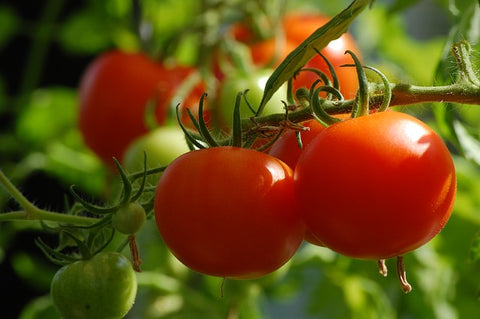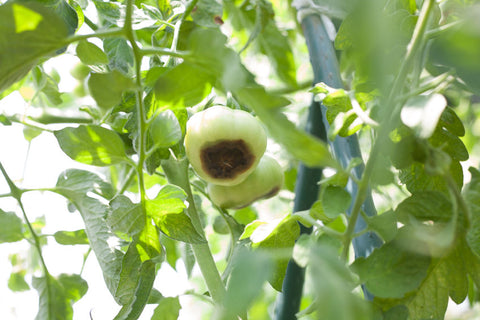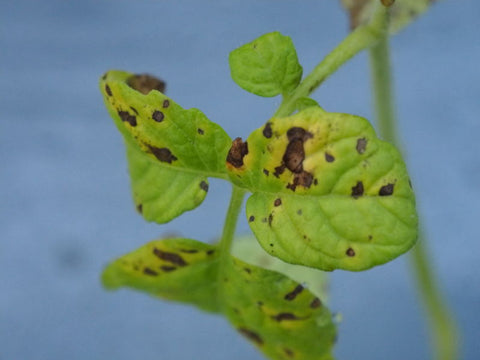Keeping your tomato plants healthy and free from tomato diseases that can plague the plant leaves is a top priority for all gardeners. After all your time and effort, you want the best tomatoes possible, right?
In addition to tomato plant diseases, you might also have to deal with problems caused by cold weather, as well as garden insect pests. Though tomatoes are not the easiest plants to cultivate from seedling to harvest, so it's important to know what to watch for.
How to Keep Your Tomato Plants Healthy

- Plant Disease-Resistant Varieties: Adding disease-resistant plants to your garden can help you avoid problems. Jasper cherry tomatoes are known to be resistant to early and late blight.
- Space Plants Properly: Tomato plants need good airflow to prevent diseases. Follow the recommended spacing instructions that come with plants to make sure you are giving them room to breathe.
- Water Properly: Water is the key to a plant’s survival. Too much and too little water can negatively affect your plants. Know how much moisture your plant needs and be consistent. Water at ground level to avoid moisture gathering on leaves.
- Add Mulch: Plant diseases can spread when soil or water exposed to an infected plant makes contact with a healthy plant. Mulch can help to prevent this from happening.
- Rotate Crops: Shaking things up every year can help prevent plant diseases and pests. Moving plants around helps to keep the soil healthy and protects plants from previously infected soil.
- Trim Plants: Pruning your plants can help keep them healthy. Overtime, plants near the bottom of the stem have a higher chance of developing diseases. Trimming these can help prevent problems. Make sure to remove any damaged leaves you find to help keep diseases or pests from spreading.
- Check for Pests: Take time to examine your plants for pests like aphids, mealybugs, and scale insects. Pests can weaken plants making them more susceptible to diseases. If you spot pests, use a plant-based insecticide spray, like our 3-in-1 Garden Spray, to help protect your plants from hungry pests.
Tomato Diseases
As your tomato plants grow, watch for tomato plant diseases such as tomato wilt that can manifest themselves as fungi, bacteria, or viruses. When autumn comes, if you have had any tomato plant disease problems (or pests) at all, extract the entire plant. You should be rotating tomatoes so that they are growing in the same patches of ground only every four years or so (many tomato plant diseases and tomato pests reside in the soil!).
Blossom Drop

A plant disease known as "Blossom drop" is apparent when temperature extremes cause tomato plants to shed developing blossoms (warmer than 85 degrees and cooler than 58 degrees F). More often than not, damage is not noticeable until later in the season when you'll see your tomato harvest impaired.
You can help prevent blossom drop by installing row covers to help keep your plants warmer at night, but unfortunately, you won't be able to do much about the effects caused by daytime temperatures. If you keep your tomato plants as healthy as possible, however, they can set new buds after the hot days pass.
Damping Off
"Damping off" can be a frustrating fungal disease, causing germination failure or seedlings to collapse. To help prevent damping off, try presoaking seeds to speed up germination, and plant them with soil at optimum temperature (not during extreme temperatures). When planting seeds in a potting mix, be sure to use sterile containers and potting soil. Allow soil to dry between waterings.
Blossom-end Rot

When your tomato plants suffer from a lack of calcium (usually caused by inconsistent water availability), you might see what's known as blossom-end rot. What does blossom-end rot look like? Like a sunken, dead area on the blossom side of the tomato, opposite the stem. This area will grow wider on your tomatoes as they mature.
Help prevent blossom-end rot with steady, stress-free plant growth. Water plants regularly (but not too much) to maintain damp soil. Spread mulch (About 2 inches thick) around your tomato plants to help keep the soil moist.
Sunscald
Sunscald is basically sunburn on a tomato, causing the fruit to become discolored, dry, and mushy. You can help prevent sunscald by promoting healthy leaves, so your tomatoes get plenty of shade. You may need to use a shade cloth.
Septoria Leaf Spot

Septoria leaf spot is a fungus and a very common form of tomato plant leaf disease. You'll first notice the fungus when it creates small, circular spots with dark edges and a grayish center (sometimes with smaller black spots in the center). Diseased tomato plant leaves will turn yellow, withered, and fall off the stem. Extended stretches of warm, wet weather can help cause this particular tomato plant disease, and the even worse news is that spores can be spread around to other leaves and plants by splashing water.
You can help control leaf spot by not crowding your tomatoes too closely together. Leave enough space between plants so air can circulate and leaves can properly dry between watering and rainfalls. Try to avoid overhead watering (water the base of the plant). Also, morning watering is better, to give leaves ample time to dry before nightfall.
Fusarium and Verticillium Wilt
Fusarium and Verticillium wilt are caused by fungi in the soil that enters your tomato plants through the tender, young roots. The fungi then plugs the vessels that gets water from the roots to the stems. As you can imagine, your plants will begin to decay due to lack of water flow. On sunny days your plants will appear wilted, then appear to recover during the night (wilting may first appear in the lower or upper leaves of the plant, causing discoloration). Eventually leaves will die backward from the leaf tips as the wilting spreads throughout the entire tomato plant. Fusarium wilt is the most common tomato plant disease in regions with warm weather regions as well as in cooler regions during the periods of warmest weather.
To avoid these tomato plant wilt diseases, make a point to plant tomatoes bred for disease resistance (Heirloom tomato varieties in particular not bred to withstand these types of diseases are particularly susceptible to tomato wilt). Look for plants labeled with an "F," "FF," or "FFF" (for Fusarium variations), or with a "V" (for Verticillium). Be sure not to overwater your tomato plants--a wilted plant does not mean it needs more water, so check the soil. If it's dry, then go ahead and water.
If your tomato plants are affected by any of these wilt diseases, extract and destroy them. Do NOT place them in your compost pile. Do not plant tomatoes, peppers, potatoes, or eggplants in affected soil for four to six years because of residual fungus that remains in the soil (corn and beans won't be affected). Keep affected soil well weeded as their roots continue feeding on the fungi.
Anthracnose

Antrhacnose is another fungus that will manifest itself as a small circular indentation on your tomatoes. Rings will eventually surround the original spotted area. Even if the tomato fruit skin doesn't rot completely through, continue to pick your tomatoes as they ripen. As with Septoria leaf spot disease, fungus spores are spread around by splashing water, and the fungus thrives in warm, wet weather. Follow the same steps (proper spacing, watering in the morning, watering the base of the tomato plants to allow leaves time to dry, etc.) to protect your tomato plants from the anthracnose fungus.
Late Blight (Phytophthora infestans)
There is also a "late blight" that can threaten your tomato plants, inflicted by the Phytophthora infestans fungus, which can occur during periods of cool, rainy weather (common toward the end of your growing season). It appears almost like frost damage on the tomato plant leaves (greenish-black/bluish-grey splotches), with browning and dropped leaves. Your tomatoes may have oily, brown blotches that can rot quickly. This particular tomato plant disease can also transfer to and harm nearby potatoes.
To help prevent both early and late blight from occurring, try spacing out the plants and water carefully so the leaves can air out (as you would for Septoria leaf spot prevention).
Early Blight (Alternaria)

Yet another tomato plant fungus known as Alternaria solani causes leaf spot or early blight. The Alternaria fungus overwinters in the soil and in diseased plants. Early blight shows up as concentric rings on lower leaves, which eventually yellow and drop, which can cause sunscald on your tomatoes. The lower leaves will show brown or black spots with dark edges (like a bullseye). Tomato stem ends may also be attacked, showing large, sunken black areas in the fruit, with concentric rings. This particular tomato plant disease usually appears after tomatoes start appearing.
Mosaic Virus
The Mosaic virus commonly attacks various kinds of plants including tomatoes. The virus won't kill the plant, but hinders the quality and quantity of your tomato crop. You'll notice what resembles a "mosaic" of light green to yellow coloring on the tomato leaves and an unhealthy looking texture on the tomatoes themselves. Leaves may also grow misshapen, almost looking like fern leaves.
Avoid handling the plant as much as possible, as the virus enters the plant through a cut in stems or leaves. Also, note that tobacco users are prone to transmit the disease to the plants, so thorough hand washing with soap is important if handling is necessary. It's important to stick with virus-resistant plants, and to avoid replanting tomatoes in areas previously infected for a season or two.
Tomato Bacterial Diseases
Tomatoes can fall prey to a number of tomato plant bacterial diseases, including bacterial spot, bacterial speck, and bacterial canker. They're all slightly different but appear as spots on leaves and fruits. Use the same controls as for septoria leaf spot. Grow disease-resistant plants. Avoid rotating the same ground with peppers, which can host the same diseases. Avoid pruning and tying plants, because the bacteria can enter any openings made during these procedures. Fixed copper sprays may reduce the spread if applied as soon as symptoms begin.
Plant Oil-based Garden Spray
To help minimize the effects caused by weather, tomato plant pests, and tomato plant diseases, try an effective plant-based 3-in-1 garden spray to address pests, mites, and fungi. Look for a garden spray that you can use for organic gardening, indoors and outdoors, and that does not leave behind harmful residues.
What are your go-to gardening tips and tricks? We want to hear about them! Comment below!

For scientifically-tested, effective pest control in your garden that is friendly to the environment, try Maggie’s Farm pest control products. Our promise is that our plant and mineral-based products are developed by scientists and seasoned pest control professionals to be the most effective.
